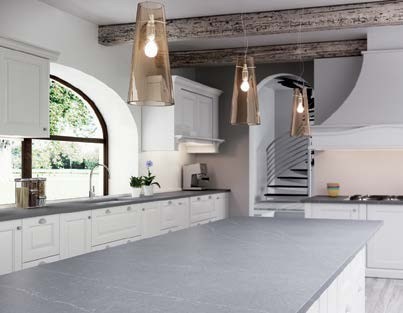When it comes to the kitchen, the countertop is where all the action happens – that’s why durability is essential.


When it comes to the kitchen, the countertop is where all the action happens – that’s why durability is essential. Its aesthetic value, too, is key, being the dominant visual focus in the space. We explore nifty materials to consider.
LAMINATES
A composite material made of layers of paper and plastic resins, laminates are topped with a layer printed with a decorative pattern or colour andthen pressed to form a durable, non-porous surface that works as a kitchen countertop surface.
Price-wise, such countertops are in the lowto mid-range categories, compared to other surfaces.
Laminates can be an earthfriendly option, with some brands using paper that is recycled or sourced from FSC-certified forests. They are also easy to install and can be adapted for use in L-shaped or extended kitchens, thanks to its tight, clean seams.
Its heat resistance is limited, so it’s not advisable to place hot pots directly on the surface to avoid burning it. Take note that sharp objects like knives and scissors can nick the surface.
SOLID SURFACING
For many years, solid surfaces have ruled the roost – and for good reason. A manufactured material consisting of polymer resins mixed with minerals and colourants, solid surfaces are durable, non-toxic and hygienic. They offer excellent versatility too. Produced in sheets, solid surfaces can be fabricated into countertops, backsplashes and even cabinet fronts.
Because there is no veneer or coating, solid surfaces have the same colour and composition throughout. Note that while the material is non-porous and generally resistant to stains, this depends largely on the quality and composition of resins and other materials. Aside from being susceptible to scratches, it is also not heat-resistant.
That said, solid surfaces can be sanded to make it look like new. This also means that it is perfect for L-shaped kitchens, where the solid surface sheets can be glued together and then sanded to remove the seams. The material can also be shaped, carved and sanded to create a surface that can accommodate other kitchen necessities. As this is a manufactured material, it can be produced in a wide range of colours and patterns to accommodate tastes. If your kitchen will see moderate to heavy-duty use, solid surfaces should be considered.
ENGINEERED QUARTZ
Engineered quartz is a material that’s rising in popularity among homeowners. It is made of at least 90 per cent ground quartz that is mixed with resins and pigments to produce a host of looks that mimic concrete and natural stone, and covers a spectrum of colours.
Considered a premium material, it provides a host of benefits. If you cook daily, engineered quartz is an ideal surface. It is durable and non-porous, so there’s no need to apply sealant regularly to protect it from stains.
Engineered quartz is produced in slabs that vary in size according to the manufacturer. If you are particular about seams, engineered quartz is more suited to compact linear kitchens. When it comes to toughness, engineered quartz trumps natural stone and is perfect for heavy-duty use.
1.Greenlam’s 12mm-thin Stratus AFX laminate worktops have been treated to create a super matte and non-porous surface. It’s easy to remove fingerprints, dirt and grease marks from the surface.

2. Consider cladding the backsplash and countertop with the same laminate for a clean look.

3. Laminates allow for a range of colours, including unconventional choices like soft pink.

4. Laminates make a versatile surface material, and is perfect for cladding all the surfaces of a kitchen island.

5. Laminate countertops also come in finishes that look like stone. They are an affordable alternative to other countertop materials.


7. Evershine offers a wide selection of solid surface designs, including patterns such as terrazzo and granite.



10. Among the latest from Caesarstone is the 4023 Topus Concrete, inspired by fossilised stone and combined with a weathered, industrial look. The pink undertone brings a warm touch to the texture.

OPTING FOR STONE TOPS
When it comes to countertops with a premium look and feel, few materials measure up to the appeal of solid or engineered stone surfaces, with marble and granite being the popular options available.
MARBLE
Natural stone like marble and granite offer a look of luxury, but there is a trend towards engineered quartz as a premium option. As it comes in slabs, seams are unavoidable. That said, stone continues to be a classic favourite.
GRANITE
DESIGN TIPS & CONSIDERATIONS
If I have a long kitchen island and I want a seam-free surface, what should I use?
Solid surfacing is your best bet. The solid surface panels are glued together and then sanded to remove the appearance of seams.
I love black, but I want a unique texture. What should I use?
The kitchen countertop is an area that usually sees heavy-duty use. Therefore, a smooth surface makes the kitchen easier to clean. That said, you can go for laminates if you wish to have subtle textures. Another option is to have light patterns on your countertops; surface materials such as laminates, engineered quartz and natural stone offer this.
Does the island need to be in the same material/colour as the countertops in the rest of the kitchen?
There are no hard and fast rules. You can opt for a standout colour for the island, to turn it into the star of the space.























